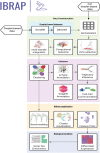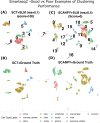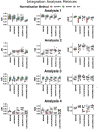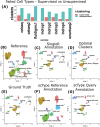IBRAP: integrated benchmarking single-cell RNA-sequencing analytical pipeline
- PMID: 36847692
- PMCID: PMC10025434
- DOI: 10.1093/bib/bbad061
IBRAP: integrated benchmarking single-cell RNA-sequencing analytical pipeline
Abstract
Single-cell ribonucleic acid (RNA)-sequencing (scRNA-seq) is a powerful tool to study cellular heterogeneity. The high dimensional data generated from this technology are complex and require specialized expertise for analysis and interpretation. The core of scRNA-seq data analysis contains several key analytical steps, which include pre-processing, quality control, normalization, dimensionality reduction, integration and clustering. Each step often has many algorithms developed with varied underlying assumptions and implications. With such a diverse choice of tools available, benchmarking analyses have compared their performances and demonstrated that tools operate differentially according to the data types and complexity. Here, we present Integrated Benchmarking scRNA-seq Analytical Pipeline (IBRAP), which contains a suite of analytical components that can be interchanged throughout the pipeline alongside multiple benchmarking metrics that enable users to compare results and determine the optimal pipeline combinations for their data. We apply IBRAP to single- and multi-sample integration analysis using primary pancreatic tissue, cancer cell line and simulated data accompanied with ground truth cell labels, demonstrating the interchangeable and benchmarking functionality of IBRAP. Our results confirm that the optimal pipelines are dependent on individual samples and studies, further supporting the rationale and necessity of our tool. We then compare reference-based cell annotation with unsupervised analysis, both included in IBRAP, and demonstrate the superiority of the reference-based method in identifying robust major and minor cell types. Thus, IBRAP presents a valuable tool to integrate multiple samples and studies to create reference maps of normal and diseased tissues, facilitating novel biological discovery using the vast volume of scRNA-seq data available.
Keywords: analytical pipeline; benchmarking; cell annotation; data integration; single-cell RNA-seq.
© The Author(s) 2023. Published by Oxford University Press.
Figures





Similar articles
-
Single-Cell RNA Sequencing Analysis: A Step-by-Step Overview.Methods Mol Biol. 2021;2284:343-365. doi: 10.1007/978-1-0716-1307-8_19. Methods Mol Biol. 2021. PMID: 33835452
-
Supervised application of internal validation measures to benchmark dimensionality reduction methods in scRNA-seq data.Brief Bioinform. 2021 Nov 5;22(6):bbab304. doi: 10.1093/bib/bbab304. Brief Bioinform. 2021. PMID: 34374742 Review.
-
Benchmarking UMI-based single-cell RNA-seq preprocessing workflows.Genome Biol. 2021 Dec 14;22(1):339. doi: 10.1186/s13059-021-02552-3. Genome Biol. 2021. PMID: 34906205 Free PMC article.
-
A multicenter study benchmarking single-cell RNA sequencing technologies using reference samples.Nat Biotechnol. 2021 Sep;39(9):1103-1114. doi: 10.1038/s41587-020-00748-9. Epub 2020 Dec 21. Nat Biotechnol. 2021. PMID: 33349700 Free PMC article.
-
Evaluation of single-cell classifiers for single-cell RNA sequencing data sets.Brief Bioinform. 2020 Sep 25;21(5):1581-1595. doi: 10.1093/bib/bbz096. Brief Bioinform. 2020. PMID: 31675098 Free PMC article. Review.
Cited by
-
Decoding the mosaic of inflammatory bowel disease: Illuminating insights with single-cell RNA technology.Comput Struct Biotechnol J. 2024 Jul 11;23:2911-2923. doi: 10.1016/j.csbj.2024.07.011. eCollection 2024 Dec. Comput Struct Biotechnol J. 2024. PMID: 39421242 Free PMC article. Review.
-
Advances in the Application of Single-Cell Transcriptomics in Plant Systems and Synthetic Biology.Biodes Res. 2024 Feb 29;6:0029. doi: 10.34133/bdr.0029. eCollection 2024. Biodes Res. 2024. PMID: 38435807 Free PMC article. Review.
-
Comparative study on differential expression analysis methods for single-cell RNA sequencing data with small biological replicates: Based on single-cell transcriptional data of PBMCs from COVID-19 severe patients.PLoS One. 2024 Mar 27;19(3):e0299358. doi: 10.1371/journal.pone.0299358. eCollection 2024. PLoS One. 2024. PMID: 38536877 Free PMC article.
-
A Current Perspective of Medical Informatics Developments for a Clinical Translation of (Non-coding)RNAs and Single-Cell Technologies.Methods Mol Biol. 2025;2883:31-51. doi: 10.1007/978-1-0716-4290-0_2. Methods Mol Biol. 2025. PMID: 39702703
-
Challenges and best practices in omics benchmarking.Nat Rev Genet. 2024 May;25(5):326-339. doi: 10.1038/s41576-023-00679-6. Epub 2024 Jan 12. Nat Rev Genet. 2024. PMID: 38216661 Review.
References
-
- Ziegenhain C, Vieth B, Parekh S, et al. . Comparative analysis of single-cell RNA sequencing methods. Mol Cell 2017;65:631–643.e4. - PubMed

